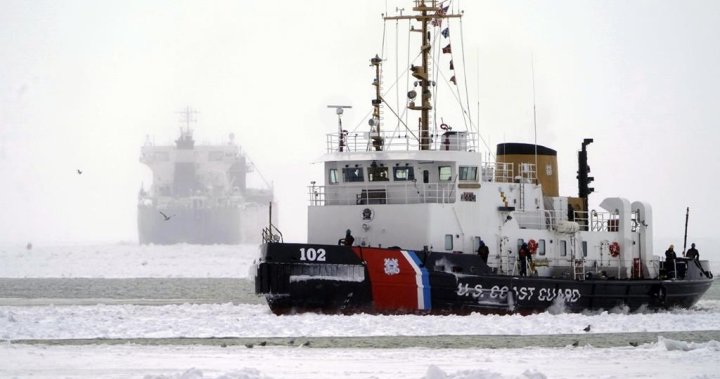Paragraph 1: The Manitoulin’s Icy Predicament
The Canadian freighter Manitoulin, a 663-foot (202-meter) vessel carrying 17 crew members, became ensnared in the icy grip of Lake Erie on Wednesday, January 22, 2025. The ship had just completed a delivery of wheat in Buffalo, New York, and was en route back to Canada when it encountered thick ice, rendering it immobile. This incident highlights the challenges faced by Great Lakes freighters during the winter months, where surface ice is common, but occasionally presents impassable barriers. Despite the frigid conditions and the unexpected delay, the Manitoulin remained undamaged, and its crew remained safe throughout the ordeal.
Paragraph 2: A Multinational Rescue Effort
Responding to the Manitoulin’s distress call, a U.S. Coast Guard icebreaker arrived on Thursday, January 23rd, to commence the rescue operation. Recognizing the difficulty of the situation, a second U.S. Coast Guard vessel joined the effort on Saturday, January 25th, bolstering the icebreaking capabilities. The Canadian Coast Guard also dispatched a ship to assist in freeing the trapped freighter, demonstrating the collaborative spirit of international maritime assistance. This combined effort underscores the importance of coordinated responses to maritime emergencies, especially in challenging environmental conditions.
Paragraph 3: Breaking Free and the Journey Home
After days of relentless work by the combined Coast Guard forces, the Manitoulin was finally freed from the icy clutches of Lake Erie on Saturday, January 25th. The icebreakers carved a path through nearly 20 miles (32 kilometers) of ice, escorting the Manitoulin from its trapped position near Buffalo to open water. This marked a significant victory for the rescue teams and a welcome relief for the crew of the Manitoulin. The freed freighter now faced the task of navigating the remaining stretch of Lake Erie and then traversing the Detroit and St. Clair Rivers to reach its final destination in Canada, where it would remain for the remainder of the winter season.
Paragraph 4: Continued Escort and Monitoring
While the Manitoulin had escaped the immediate ice trap, its journey home was not without further challenges. Recognizing the ongoing ice conditions in other parts of Lake Erie and the connecting rivers, the U.S. Coast Guard continued to provide an escort. A different Coast Guard cutter was assigned to guide the Manitoulin through the remaining icy stretches, ensuring safe passage. Meanwhile, a U.S. Coast Guard helicopter maintained aerial surveillance, monitoring the situation and providing real-time updates to the rescue teams. This proactive approach highlights the Coast Guard’s commitment to ensuring the safe navigation of vessels through challenging waterways.
Paragraph 5: Contingency Planning and Preparedness
In anticipation of potential further complications, the U.S. Coast Guard had a third icebreaker on standby, scheduled to arrive on Monday, January 27th, if the Manitoulin encountered further difficulties. Although the Manitoulin was successfully freed without requiring the third vessel’s intervention, this proactive contingency planning demonstrates the Coast Guard’s dedication to preparedness and their commitment to ensuring the safety of maritime operations. The deployment of multiple resources and the development of contingency plans reflect a comprehensive approach to managing complex maritime situations.
Paragraph 6: Winter Challenges on the Great Lakes
The Manitoulin’s ordeal serves as a reminder of the unique challenges posed by winter conditions on the Great Lakes. While freighter traffic continues throughout the year, ice formation presents significant navigational hazards. Although encountering surface ice is a routine occurrence for Great Lakes freighters, situations like the Manitoulin’s highlight the potential for vessels to become trapped in particularly thick or hard ice. This incident underscores the importance of robust icebreaking capabilities and the critical role of coordinated international efforts in ensuring the safety and efficiency of maritime transport on the Great Lakes during the winter months.

